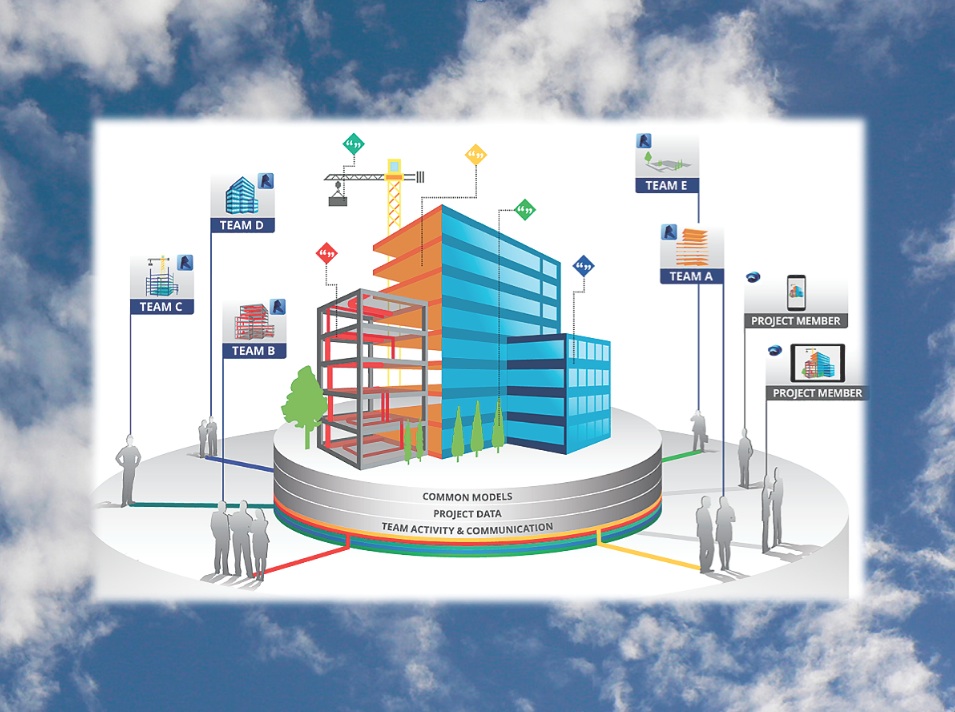The AEC industry has made incredible advancements with parametric modeling during the past 25 years, but the BIM/VDC movement is still relatively in its infancy. Technology gaps, interoperability issues, antiquated project delivery methods, and liability concerns are among the barriers preventing the industry from achieving the full power of BIM/VDC tools on building projects.
A prime example is the promise of true multi-discipline, multi-location, real-time collaboration using a single project model. Sure, the technological capability to do so has been available for several years, but for a host of reasons—from a lack of technical know-how to contractual nitpicks—few Building Teams have taken BIM/VDC coordination to this level. We’re starting to see more Building Teams co-locate for the duration of projects—especially for complex, multi-year projects, like hospitals and government buildings—to improve coordination efforts. But what about virtual co-location?
That’s the promise of “BIM in the cloud,” where project models are hosted virtually to permit multiple project team members in different locations to work on the same model in real time, as if they were in the same room. The major BIM software players—as well as a handful of progressive AEC firms and cloud solution providers, like Citrix, Panzura, and VMWare—have been scrambling the past few years to develop cloud-based BIM solutions. Autodesk, Bentley, Graphisoft, Nemetschek, and Trimble all offer cloud products and services, and encouraging AEC firms to shift to cloud-centric workflows.
“In an ideal world, everyone would be in one office and working off the same network, but that’s just not the reality of how design and construction work today,” says Bjorn Clouten, AIA, Senior Associate/BIM Manager with SRG Partnership. “Cloud-based modeling is critically needed for the industry. It’s something that we’ve been pushing for over the past decade.”
During his 11 years heading SRG’s BIM efforts, Clouten has implemented and experimented with a number of cloud-based modeling approaches, with mixed success. The firm recently beta-tested Autodesk’s newly launched A360 Collaboration for Revit cloud platform for the design coordination of the planned Oregon State Capital Renovation in Salem. The cloud platform allowed a significant portion of the design team, including SRG’s team and designers from the associate architect, structural engineer, MEP engineer, and low-voltage engineer, to coordinate in real time on a single Revit model.
Besides the improved coordination and time savings from not having to exchange models once a week, this technology simplified the process “considerably” by eliminating the need to do workarounds, says SRG’s Clouten. “We have the current information all the time, so we’re not always two weeks behind on the design information.”
5 lessons from moving BIM to the cloud
Like any emerging technology, cloud-based modeling has nuances that can be nettlesome for firms that are new to the process. BD+C asked several early cloud adopters to share their lessons and takeaways. They offered the following:
1. Get ready for a change in workflow. Same model, same users, what’s the difference? For starters, giving multiple users real-time access to the model can lead to logistical problems if the process is not properly managed. “Communication becomes even more critical,” says Seth Spangler, PE, LEED AP BD+C, BEMP, Project Manager with RMF Engineering. “Architects are moving walls and ceilings at the same time engineers are placing diffusers and lights. These same adjustments can have catastrophic effects if the model or families are not configured properly.”
The need for a cohesive BIM execution plan is greater than ever, says Thom Chuparkoff, AIA, LEED AP, Associate with Populous. “The BIM plan should provide a clear understanding of factors like model exchanges, storage, naming conventions, and organization of the model,” he says. “This will allow for a seamless inclusion of models throughout the life of the documentation process.”
2. Communication is more critical than ever. Chuparkoff recommends at least weekly coordination meetings. Depending on what’s being worked on, coordination could involve daily, hourly, or even “real-time” check-ins with multiple team members—as if they were physically co-located.
“Collaboration is synonymous with communication,” says Chuparkoff. “Your new workflow involves a form of partnership with your consultants that is akin to integrated project delivery.”
3. Outsource your cloud infrastructure to avoid added costs and headaches. Sean McDonald, Senior Information Technology Specialist with BIM consultant CASE, has seen a number of firms get into trouble developing their own cloud infrastructure.
“These projects start off the same way: ‘Let’s just buy a server rather than pay all these monthly fees,’” says McDonald. “But there are a number of hidden costs that most firms don’t see until it’s too late.”
Licenses for server software can be “outrageously expensive,” he says, and clouds are labor intensive—“especially if you consider that any down time will potentially prevent your entire firm from working.”
4. Cloud solutions can be IT-intensive. Depending on the approach, the level of IT expertise required for cloud solutions can be extensive. For example, implementing Autodesk’s Revit Server between two firms requires a relatively high level of expertise to be able to enter the IP addresses, configure VPNs, and work with firewalls, says SRG Partnership's Clouten. On the other hand, he says Autodesk’s A360 Collaboration for Revit is much simpler, requiring the installation of a few plug-ins.
Clouten advises firms to make sure that all BIM cloud users are equipped with a workstation and broadband service robust enough to handle very large BIM files. Cloud applications are similar to how BIM workflows operate within a local network. “You have the central copy in the cloud and the local copy on the hard drive,” he says. “Local storage space is an item to be aware of.”
5. The cloud can be temperamental, so be patient. Server problems, syncing delays, broadband hiccups—these are just a few of the ongoing headaches reported by the AEC cloud experts. Don’t expect uptime to be 100%—not even Google can claim to offer that level of reliability—and have a backup plan for when your connections are down.
Related Stories
BIM and Information Technology | Jul 20, 2015
New stylus brings digital sketching to the next level
Without buttons, users can change the weight of the stylus’ stroke.
BIM and Information Technology | Jul 16, 2015
BIM for O+M: New app streamlines project documentation handover process
The Building Ops app enables owners to begin operations on the first day with a turnkey maintenance and asset management solution, according to its maker, Autodesk.
BIM and Information Technology | Jul 15, 2015
Google launches open-source beacon platform: Eddystone
Though beacons usually broadcast information publicly, Eddystone has the option to communicate privately as well, which greatly expands the applications for the technology.
BIM and Information Technology | Jul 14, 2015
New city-modeling software quantifies the movement of urban dwellers
UNA for Rhino 3D helps determine the impact that urban design can have on where pedestrians go.
BIM and Information Technology | Jul 14, 2015
Nation’s first 'drone park' breaks ground in North Dakota
This is one of six testing sites around the country that are developing flight standards and evaluating the utility of drones for different tasks.
BIM and Information Technology | Jul 6, 2015
BIM/VDC training is more than learning the features
Training can be a taxing experience for both the class and the instructor. CASE's Nathan Miller offers four ways to make training more relevant to practitioners.
BIM and Information Technology | Jul 6, 2015
Researchers increase GPS precision to centimeter-accurate
A new startup is working with Samsung to develop a snap-on accessory for centimeter-accurate global positioning.
BIM and Information Technology | Jul 6, 2015
New documentary shows Legos as touchstones of creativity
The film's narrator, actor Jason Bateman, says it’s a story “about a simple toy and how its unique properties ushered in a new era of creativity for a whole generation.”
BIM and Information Technology | Jul 1, 2015
World’s first fully 3D-printed office to be produced in Dubai
A 20-foot-tall printer will be needed for the project, spewing out construction material consisting of special reinforced concrete, fiber reinforced plastic, and glass fiber reinforced gypsum.
Sponsored | BIM and Information Technology | Jun 23, 2015
Emerging technology reinvents construction principals
Gilbane discovered the anecdotal side of laser scanning pales in comparison to the dramatic ROI story.

















